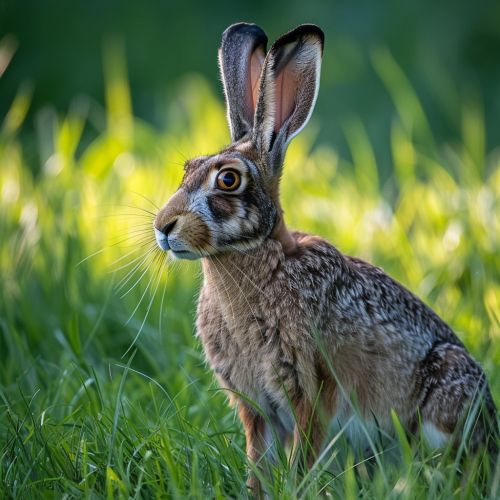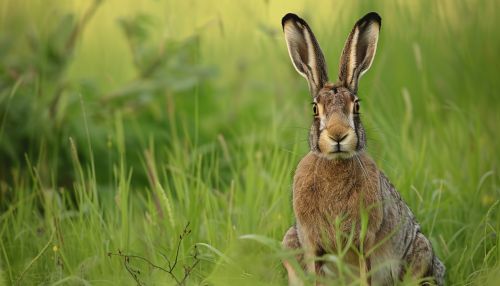Hare
Taxonomy and Evolution
The Leporidae family of the Lagomorpha order comprises more than 60 species of mammals, commonly known as hares and rabbits. The term "hare" is used to refer to species in the genus Lepus, which are typically larger, have longer ears, and are less social compared to rabbits.


Hares are believed to have evolved in the Miocene epoch, approximately 20 million years ago, in central Asia. The oldest known fossil of a hare, Lepus alleni, was found in North America and dates back to the late Miocene. The evolution of hares is characterized by adaptations to diverse environments, from arctic tundra to desert landscapes.
Anatomy and Physiology
Hares are medium to large-sized mammals, with long, powerful hind legs adapted for fast running. They have large, elongated ears which aid in heat regulation and provide acute hearing. The eyes of a hare are positioned high on the sides of the head, providing a wide field of vision. The fur color varies among species and is often seasonally changeable in arctic hares, providing camouflage against predators.
The digestive system of hares is adapted to a herbivorous diet, with a large cecum that allows for the fermentation of plant material. Hares practice coprophagy, consuming their own feces to extract maximum nutrients from their food.
Behavior and Ecology
Hares are primarily nocturnal and spend most of the day in a shallow depression or flattened nest-like form known as a "form". Unlike rabbits, hares do not dig burrows but rely on their speed and agility to escape from predators.
Hares are generally solitary animals, although they can be seen in pairs or small groups during the breeding season. This period, known as the "march madness", is characterized by males (bucks) fighting for access to females (does) and high-speed chases.
Hares are known for their unique behavior of "boxing", where a female hits a male with her forepaws to ward off his advances or to test his determination.
Reproduction and Lifespan
Hares have a polygynous mating system, with males mating with multiple females. The gestation period lasts around 42 days, after which a litter of 1 to 8 leverets (young hares) is born. Unlike rabbits, hares give birth to precocial young, which are born fully furred and with their eyes open.
The lifespan of hares varies among species, with smaller species typically living up to 4 years, and larger species up to 7 years in the wild. Predation and harsh environmental conditions are the primary causes of mortality in hares.
Hares and Humans
Hares have been associated with various cultural and mythological traditions across the world. In many cultures, hares are symbols of fertility and rebirth, owing to their high reproductive rate. The hare also features prominently in the folklore and mythology of various indigenous cultures.
Hares are hunted for their meat and fur in many parts of the world. However, overhunting and habitat loss have led to the decline of several hare species, leading to conservation concerns.
